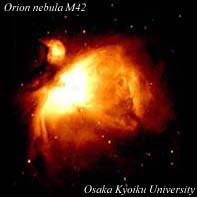 | 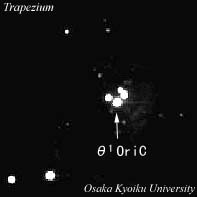 | ||||||||||
|---|---|---|---|---|---|---|---|---|---|---|---|
|
M42 is a diffuse nebula in Orion.
It has spread around the star "Trapezium" of the middle
in the group of small three stars.
Trapezium consists of four O type stars. Since their high temperature, they emit the ultraviolet radiation surrounding space. The surrounding gas is ionized in response to the received ultraviolet radiation, and it shines visibly by emission line of hydrogen etc.. The ionized gases around such young stars are called HII region.
M42はオリオン座の小三つ星の真ん中の星(トラペジウム)のまわりに広がる散光星雲です. 距離は450pcぐらいと言われています.
トラペジウムの星は生まれたばかりのO型星が4つ集まったもので
(4つまとめてθ1Oriと呼ばれています),
非常に高温なため,周囲の空間に強い紫外線を放出しています.
この4つの星の中でθ1OriCがオリオン大星雲の励起星で,
その紫外線を受けてまわりのガスが電離し,
水素の輝線などで光って見えます. By courtesy of Osaka Kyoiku Univ. | |||||||||||
Orion in 12CO(J=2-1)
Orion A in (13CO(J=1-0))
Ori A in Submillimeter Radio Wave
Ori A in CS(J=1-0) 49GHz
L1641 Cloud in Ori A
Ori A in Radio Continuum
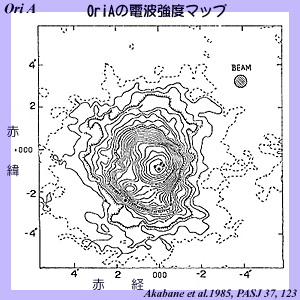
|
オリオン星雲を国立天文台野辺山45m電波望遠鏡を用いて,
周波数46GHz(波長6.5mm)の電波連続波で観測した結果です.
By courtesy of K.Akabane |
|
This is a contour map of Orion nebula in a radio continuum wave
with a frequency of 46GHz (wavelength of 6.5mm)
by the Nobeyama 45m Radio Telescope.
Orion Nebula is not visible in visible light, but it is completely by the radio wave. By measuring the radio wave intensity in detail, we can find the state of the HII region and the intensity of the ultraviolet ray. オリオン星雲は,電離水素領域なので,そこにある自由電子から電波が放射されています. 太陽系に比較的近い電離水素領域なので,強い電波源として古くから認識されており, オリオン座で最強の電波連続波源として,「オリオン座A」と呼ばれることもあります. 12′×12′の範囲を電波強度に応じた等高線で示してあります. 図中のBEAMと付記された円が分解能を示します. 同じ領域の可視光の写真と比べてみると, 電波を放射している領域が星雲として光っている領域とほぼ一致していることが分かりますが, 詳細に比較してみると, 可視光は星間塵によって減光されている部分でも,電波ではちゃんと見えていることが分かります. 電波強度を詳細に測ることによって, 電離水素領域の状態やそれを光らせている恒星の紫外線強度などを知ることができます. 図の中心付近の電波が一番強いところは, トラペジウムのθ1Oriと一致していて, この星がオリオン星雲を光らせていることもはっきりとわかります. | |
Orion nebula in Infrared Rays
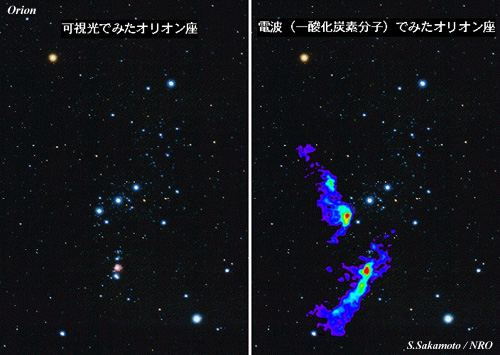
 CO(J=2-1) intensity and (J=2-1)/(J=1-0) ratio in Orion A and B
CO(J=2-1) intensity and (J=2-1)/(J=1-0) ratio in Orion A and B
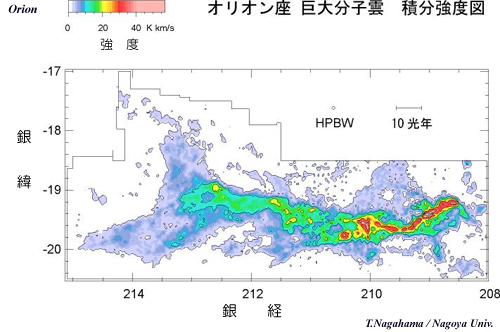

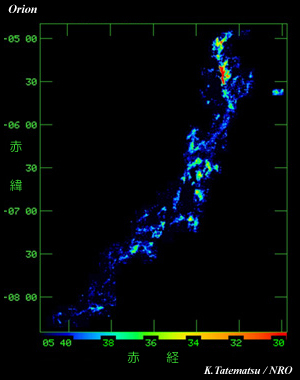

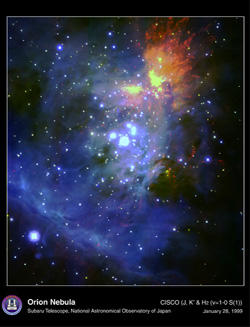

 Go to Submenu
Go to Submenu Go to Menu
Go to Menu